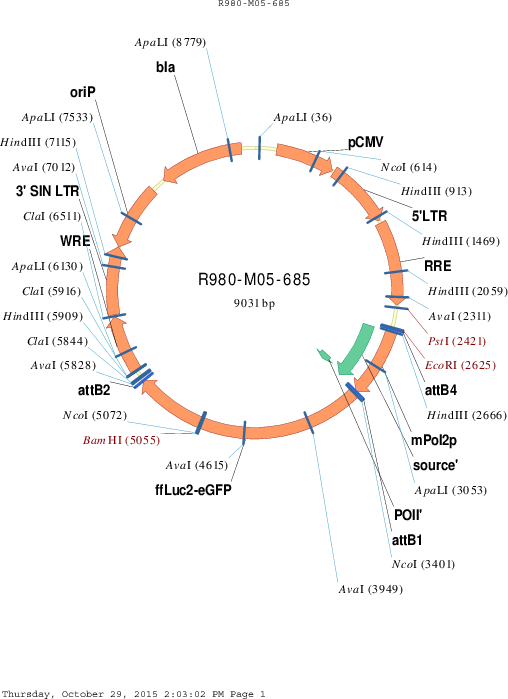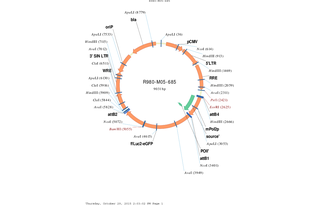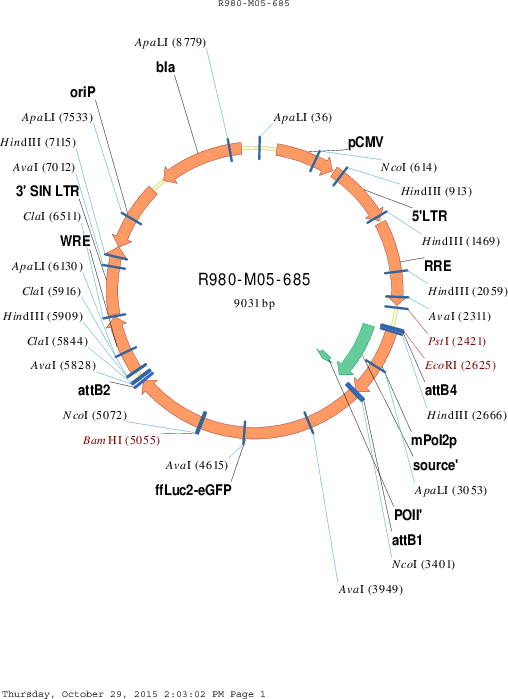-
PurposeLentiviral vector of luciferase-eGFP fusion gene driven by FerH promoter
-
Depositing Lab
-
Sequence Information
Ordering
| Item | Catalog # | Description | Quantity | Price (USD) | |
|---|---|---|---|---|---|
| Plasmid | 71393 | Standard format: Plasmid sent in bacteria as agar stab | 1 | $85 | |
Backbone
-
Vector backbonepFUGW
- Backbone size w/o insert (bp) 5828
- Total vector size (bp) 9741
-
Vector typeMammalian Expression, Lentiviral
-
Selectable markersNone
Growth in Bacteria
-
Bacterial Resistance(s)Ampicillin, 100 μg/mL
-
Growth Temperature30°C
-
Growth Strain(s)NEB Stable
-
Copy numberHigh Copy
Gene/Insert
-
Gene/Insert nameFerH-ffLuc2-eGFP
-
Alt nameSV40 enhancer-human ferritin minimal promoter- firefly luciferase-eGFP fusion gene
-
SpeciesM. musculus (mouse); firefly and jellyfish
-
Insert Size (bp)3913
- Promoter FerH
Cloning Information
- Cloning method Gateway Cloning
- 5′ sequencing primer ATCCATTCGATTAGTGAACGG
- 3′ sequencing primer GCCATACGGGAAGCAATAGC (Common Sequencing Primers)
Resource Information
-
Supplemental Documents
-
A portion of this plasmid was derived from a plasmid made byeGFP gene was synthetically produced. FerH promoter was amplified from a plasmid from Invivogen
Terms and Licenses
-
Academic/Nonprofit Terms
-
Industry Terms
- Not Available to Industry
Trademarks:
- Zeocin® is an InvivoGen trademark.
These plasmids were created by your colleagues. Please acknowledge the Principal Investigator, cite the article in which the plasmids were described, and include Addgene in the Materials and Methods of your future publications.
-
For your Materials & Methods section:
pFUGW-FerH-ffLuc2-eGFP was a gift from Glenn Merlino (Addgene plasmid # 71393 ; http://n2t.net/addgene:71393 ; RRID:Addgene_71393) -
For your References section:
Lentivirus-mediated bifunctional cell labeling for in vivo melanoma study. Day CP, Carter J, Bonomi C, Esposito D, Crise B, Ortiz-Conde B, Hollingshead M, Merlino G. Pigment Cell Melanoma Res. 2009 Jun;22(3):283-95. doi: 10.1111/j.1755-148X.2009.00545.x. Epub 2009 Jan 19. 10.1111/j.1755-148X.2009.00545.x PubMed 19175523





